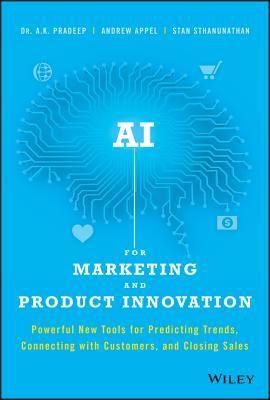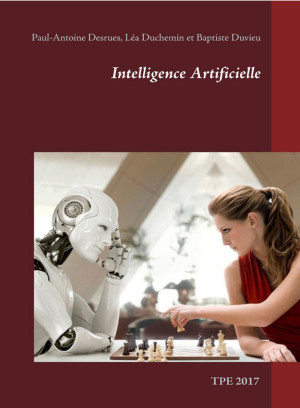Get on board the next massive marketing revolution AI for Marketing and Product Innovationoffers creatives and marketing professionals a non-tech guide to artificial intelligence (AI) and machine learning (ML)--twin technologies that stand poised to revolutionize the way we sell. The future is here, and we are in the thick of it; AI and ML are already in our lives every day, whether we know it or not. The technology continues to evolve and grow, but the capabilities that make these tools world-changing for marketers are already here--whether we use them or not. This book helps you lean into the curve and take advantage of AI's unparalleled and rapidly expanding power. More than a simple primer on the technology, this book goes beyond the "what" to show you the "how" How do we use AI and ML in ways that speak to the human spirit? How to we translate cold technological innovation into creative tools that forge deep human connections? Written by a team of experts at the intersection of neuroscience, technology, and marketing, this book shows you the ins and outs of these groundbreaking technological tools. Understand AI and ML technology in layman's terms Harness the twin technologies unparalleled power to transform marketing Learn which skills and resources you need to use AI and ML effectively Employ AI and ML in ways that resonate meaningfully with customers Learn practical examples of how to reinvest product innovation, brand building, targeted marketing and media measurement to connect with people and enhance ROI Discover the true impact of AI and ML from real-world examples, and learn the thinking, best practices, and metrics you need to capture this lightning and take the next massive leap in the evolution of customer connection.AI for Marketing and Product Innovationshows you everything you need to know to get on board.
-

AI for Marketing and Product Innovation Powerful New Tools for Predicting Trends, Connecting with Customers, and Closing Sales
Auteur: A.K. PRADEEP, et al.
AI for Marketing and Product Innovation Powerful New Tools for Predicting Trends, Connecting with Customers, and Closing Sales
- Auteur: A.K. PRADEEP, et al.
- ISBN: 9781119484080
-

Géopolitique de l'intelligence artificielle
Auteur: Pascal Boniface
Géopolitique de l'intelligence artificielle
- Auteur: Pascal Boniface
- ISBN: 978-2-416-00055-3
-
-

Intelligence artificielle
Auteur: Duchemin Desrues, Duvieu
Intelligence artificielle
- Auteur: Duchemin Desrues, Duvieu
- ISBN: 9782322080458
-
-

Intelligence artificielle
Auteur: Chantal Cazals, François Cazals
Intelligence artificielle
- Auteur: Chantal Cazals, François Cazals
- ISBN:
-
-

Learning Algorithms for Internet of Things: Applying Python Tools to Improve Data Collection Use for System Performance
Auteur: G. R. Kanagachidambaresan
Learning Algorithms for Internet of Things: Applying Python Tools to Improve Data Collection Use for System Performance
- Auteur: G. R. Kanagachidambaresan
- ISBN: 979-8-8688-0530-1
-
-

Internet of Things Programming Projects: Build exciting IoT projects using Raspberry Pi 5, Raspberry Pi Pico, and Python
Auteur: Colin Dow
Internet of Things Programming Projects: Build exciting IoT projects using Raspberry Pi 5, Raspberry Pi Pico, and Python
- Auteur: Colin Dow
- ISBN: 978-1-83508-295-9
-
-

L'Intelligence artificielle et l'automatisation 4.0
Auteur: ISMAHIL TCHAGBELE
L'Intelligence artificielle et l'automatisation 4.0
- Auteur: ISMAHIL TCHAGBELE
- ISBN:
-
-

Quantum Computer Science An Introduction
Auteur: N. David Mermin
Quantum Computer Science An Introduction
- Auteur: N. David Mermin
- ISBN: 978-0-521-87658-2
In the 1990's it was realized that quantum physics has some spectacular applications in computer science. This book is a concise introduction to quantum computation, developing the basic elements of this new branch of computational theory without assuming any background in physics. It begins with an introduction to the quantum theory from a computer-science perspective. It illustrates the quantum-computational approach with several elementary examples of quantum speed-up, before moving to the major applications: Shor's factoring algorithm, Grover's search algorithm, and quantum error correction. The book is intended primarily for computer scientists who know nothing about quantum theory, but will also be of interest to physicists who want to learn the theory of quantum computation, and philosophers of science interested in quantum foundational issues. It evolved during six years of teaching the subject to undergraduates and graduate students in computer science, mathematics, engineering, and physics, at Cornell University.
-

Quantum Computation and Quantum Information
Auteur: Michael A. Nielsen, Isaac L. Chuang
Quantum Computation and Quantum Information
- Auteur: Michael A. Nielsen, Isaac L. Chuang
- ISBN: 978-1-107-00217-3
This 10th anniversary edition includes an introduction from the authors setting the work in context. This comprehensive textbook describes such remarkable effects as fast quantum algorithms, quantum teleportation, quantum cryptography and quantum error-correction. Quantum mechanics and computer science are introduced before moving on to describe what a quantum computer is, how it can be used to solve problems faster than 'classical' computers and its real-world implementation. It concludes with an in-depth treatment of quantum information. Containing a wealth of figures and exercises, this well-known textbook is ideal for courses on the subject, and will interest beginning graduate students and researchers in physics, computer science, mathematics, and electrical engineering.
-

Quantum Machine Learning
Auteur: Pethuru Raj, Houbing Herbert Song
Quantum Machine Learning
- Auteur: Pethuru Raj, Houbing Herbert Song
- ISBN: 9783111342276
-
-

Quantum Machine Learning: What Quantum Computing Means to Data Mining
Auteur: Peter Wittek
Quantum Machine Learning: What Quantum Computing Means to Data Mining
- Auteur: Peter Wittek
- ISBN: 978-0-12-800953-6
-
-

Artificial Intelligence in Telemedicine: Processing of Biosignals and Medical images
Auteur: S. N. Kumar, et al.
Artificial Intelligence in Telemedicine: Processing of Biosignals and Medical images
- Auteur: S. N. Kumar, et al.
- ISBN: 978-1-032-31046-6
-